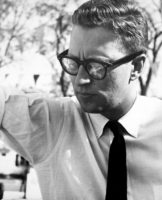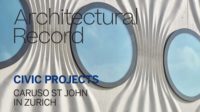California
Hovering like an umbrella over the 1,240-square-foot cabin, a curiously angled roof shelters a terrace equal in size and importance to the interior space underneath it. The terrace was originally conceived as a partially enclosed meditation room, but it was eventually opened up completely to offer panoramic views of the property, which includes a pond just below the house.
“The first design was gorgeous,” says the client, a Los Angeles—based film director who was introduced to Bow-Wow’s work through frequent travel to Japan and a mutual friend, Takashi Homma, who photographs the firm’s built work. “But I didn’t want anything too sharp or sleek, as if a UFO landed on the hill. Instead of a beautiful spaceship, I wanted a tugboat.”
That attitude guided much of the house’s design, which Yoshiharu Tsukamoto and Momoyo Kaijima, the husband-and-wife founders of Atelier Bow-Wow, developed over several visits to the site and countless models. The pair also consulted with local builder and carpenter Ken Meffan, whose own nearby house — made with the same rough-sawn wood and no-frills, custom finishings — inspired many of the details. “The way this house came together really makes you believe in process,” says the owner, who admits to being involved in every aspect of the design. “Directors make horrible clients.”
A winding driveway, sprinkled with crushed mine rock, leads to the house’s low, porticoed entry, where a built-in seating nook replaces the proverbial porch swing. Inside, larger cubbies for sitting, reading, or sleeping are positioned throughout the flowing, single-story dwelling. A seamless concrete floor enhances the space’s continuity and conceals a hydronic underfloor heating system.
Interiors also merge gracefully with exteriors. Inspired by sliding doors commonly found in Japanese homes, the main living area’s long, rectangular space features custom, oversize glass doors at both ends that open completely to the outside. Japanese influences abound. The architects angled the corridor leading to the main bedroom so that views of a large, existing granite boulder — fondly referred to as the “Zen” rock — are possible from the living area.
Though the designers initially toyed with the idea of a house made of straw bale, they settled on a construction that combined structural insulated panels (SIPs) with lumber from local mills. Exposed homasote boards, made from recycled paper, compose all interior walls, giving the space an “organic, rather than a sterile feel,” according to Meffan. The walls also serve as tackboards for pinning up drawings and photographs.
Most of the furniture is secondhand, except for the beds in the sleeping quarters, which are simply assembled on legs made from galvanized steel water pipes and kee clamps. Rooms are lit by basic bulbs hanging from cords. Other finishings required a bit more work. Sinks and bathtubs — including a functioning one outside the house — were found at a salvage yard in Berkeley and installed following some heavy-duty cleaning. The same salvage yard provided the doors. “We had to strip a hundred years of paint off them,” recalls Meffan.
While the antique doors’ shorter, narrower frames lend an odd scale to the 10-foot-high interiors, they fit right in with the house’s laid-back, quirky character — which is carried over to the loggia above, whose skewed roof can appear off-kilter. But its multidirectional rafters and crisscrossing supports create an outdoor terrace space that is both dynamic and serene. The roof shape also responds to sun and wind patterns to ensure the terrace — a spot where the residents can meditate and guests can gather for meals around a built-in eating area — is comfortable during the dry, hot summers.
The house’s humble construction recalls the vernacular architecture of the area’s old mining towns, and its use of local and natural materials pays respect to the area and its scarred earth. But Atelier Bow-Wow’s deftly arranged spaces and offbeat massing have this tugboat pushing architectural experimentation forward.
Architect:
Atelier Bow-Wow
Gross square footage:
1,240 sq. ft. (+ terrace)





Post a comment to this article
Report Abusive Comment